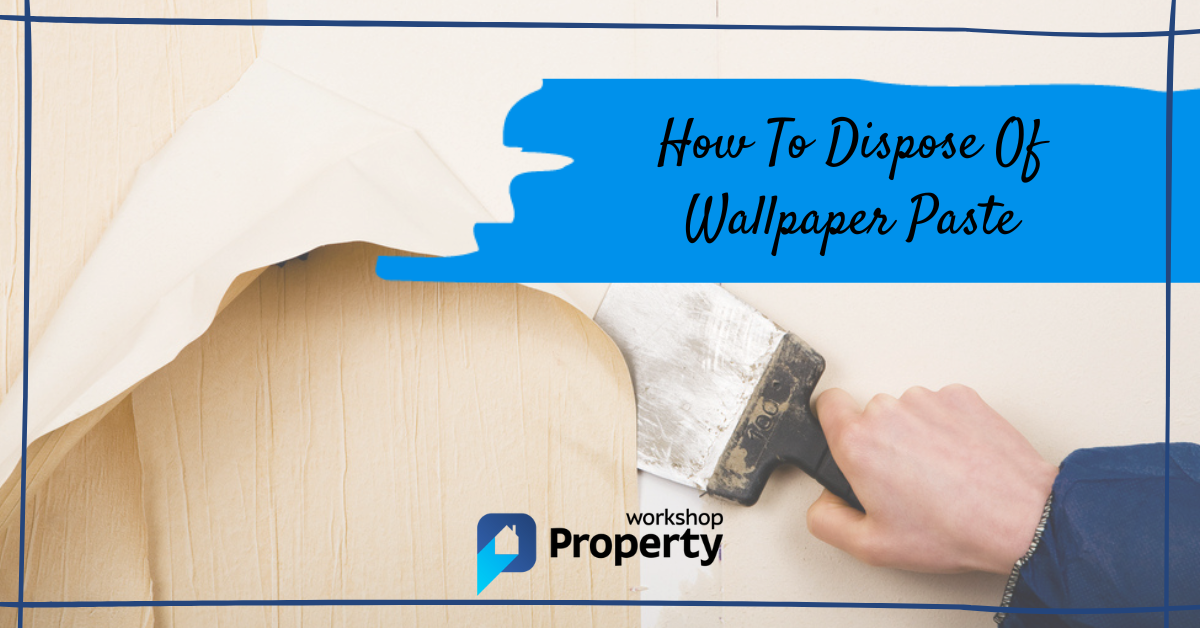Knowing how to dispose of wallpaper paste is crucial for cleaning up after a wallpapering project. Can you throw it in the trash, or do you need a specialist disposal site that handles toxic waste?
Every DIY project creates a mess (especially the ones I do), which must be disposed of somewhere. This guide shows you how to dispose of wallpaper paste in the UK so you don’t break the law or harm the environment.
Is Wallpaper Paste Toxic?
It depends on the brand. While most are made from natural ingredients, they contain a fungicide to prevent mould growth. This fungicide can be harmful, so wash your hands after contact.
Another vital ingredient is solvent, which isn’t great for the environment. The fumes can be dangerous when inhaled, so you shouldn’t sleep in a freshly papered room.
However, in the eyes of the law, wallpaper paste is considered non-hazardous and non-toxic, making it possible to discard it via standard methods.
Pro Tip: If you’re concerned, check the packaging for the safest way to dispose of your particular product.
If you lack the confidence to strip the wallpaper yourself, find a trusted decorator through Rated People.
Tools
Before we get into the nitty-gritty of how to dispose of wallpaper paste, first, we must gather the right tools for the task.
- Bucket.
- Stick.
- Warm water.
- Binbag or wheelie bin.
- Wallpaper scraper.
- Sponge.
- Jug.
- Garden hose (optional).
How To Dispose of Wallpaper Paste in the UK — Step-by-Step Instructions
There are two ways to dispose of excess wallpaper paste; both are safe and permitted within the law.
Method 1 — Throwing It in the Bin
Step 1: Collect the Paste in a Bucket
You’ll need to follow the rule of wet and dry when disposing of the wallpaper paste.
Drop it into a bucket if you scrape the paste off the wall with the wallpaper. It’s safe when dry and can go in the general waste bin. Use this method if the paste contains solvents.
If you’re revamping a new home, the old owner may have used lining paper, and you will need to scrape that off along with the paper and paste.
If you had to wet the wallpaper with a sponge, and the paste has formed a residue, collect it in a second container to dispose of later. Wallpaper paste is water-soluble, so adding moisture changes it into liquid form, making it easier to remove.
Pro Tip: Don’t use your favourite bucket for this task because you may toss away the container with the paste.
Step 2: Wait for It to Get Hard
Wet wallpaper paste sets in 24 to 48 hours. Once it gets hard, remove the paste from the bucket and throw it in the bin. It’s the safest and easiest way to dispose of excess waste.
If you have a lot of waste wallpaper paste, consider taking it to your local council rubbish disposal site.
Pro Tip: Speed drying by exposing the bucket’s contents to fresh air. If you cover it, it’ll take longer to set.
Method 2 — Down the Drain
Step 1: Add Water
Wallpaper paste is water-soluble, so it breaks down into liquid form when you add water.
Add as much water as you need to make a runny consistency. Use the mixing stick to help break up the glue and dissolve large lumps.
Step 2: Pour It Down the Drain
Once you’re satisfied that the paste is watery enough to pour, take it outside and tip it down the drain. If you doubt the paste is the right consistency, keep adding water. Wallpaper paste that’s too thick flows more slowly and sits in the drain, spelling disaster.
Pro Tip: Have a hose on standby to run water through the drain to help flush it away. Once the paste hits the sewer, it mixes with the other liquid and stays soluble.
Step 3: Pour It Down the Toilet
Rather than pouring it directly down the drain outside, you can tip it down the toilet. Use the flush and gravity to help it on its way.
Only do this if you’re confident that the paste won’t block your pipework. The last thing you want is to take the simple task of disposing of paste and turn it into a significant plumbing blockage.
Pro Tip: Remember, don’t do this with solvent-based paste, and it’s better to use the dry disposal method and throw it in the bin.
Final Thoughts
Disposing of wallpaper paste may sound simple enough, but you should consider what you’re doing in an ever-increasing eco-friendly world.
Luckily, wallpaper paste is classified as non-toxic to the environment and safe to dispose of using the methods described above. Just remember that solvent-based pastes are not suitable for pouring down the drain. If you’re unsure, find trusted professionals through Rated People.
If you feel inspired to strip off your old wallpaper and replace it with a new look, check out our guide to hanging wallpaper.
FAQs
Below are answers to frequently asked questions about the disposal of wallpaper paste.
Can I dispose of wallpaper paste down the sink?
You can throw your wallpaper paste down the sink if it’s a suitable watery consistency. It might be better to pour it down the drain outside and avoid clogging your pipes.
How do you dispose of made-up wallpaper paste?
The easiest way to throw away wallpaper paste is to let it dry in the bucket for 48 hours and throw the dried mixture in the bin. Failing that, water it down to give it the consistency of water and pour it down the drain.
Can wallpaper go out of date?
Wallpaper can be outdated, especially if the packet is opened and incorrectly sealed. Made-up wallpaper lasts two to seven days, and powdered wallpaper in an unopened container could last two to seven years.

